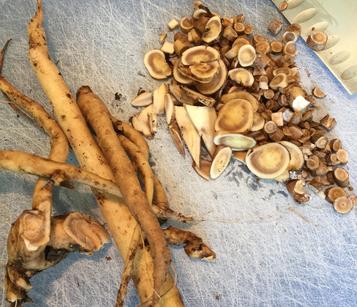
POULTRY AND ELECAMPANE ROOT
Elecampane (Inula Helenium)
I’m not sure why, but it seems that not many people have even heard of this wonderful herb. Elecampane is an herb that I always make sure to have in my house – in my Herbal Apothecary – ready for when I may need it. My first use of Elecampane was with my flock of chickens. But I now use it for any animal with any sort of cough or congestion, and I often recommend it for humans as well – for any sort of bronchial or pulmonary or respiratory system congestion.
What Is Elecampane?
Elecampane is probably native to Great Britain and Northern Europe, but because it was grown in almost every herb garden throughout the Middles Ages and all through Europe, it is hard to say. The root is the part of the Elecampane plant that is used medicinally.
What Does It Do?
Elecampane root has been used for hundreds of years for any sort of lung complaint or bronchitis. It functions in a variety of ways – it soothes and moistens the respiratory tract, it moistens and softens mucus letting it move out easier, and it acts as an expectorant, making coughing more productive. Elecampane has a long history of uses beyond aiding the pulmonary system – it has been used to sustain the spirits, act as a mild sedative, help fight infections particularly in the mouth, and it is also a traditional bitter, stimulating digestion and restoring appetite. Elecampane contains high amounts of Inulin, which is very supportive of the digestive tract.
When to Use It With Poultry
Poultry can be susceptible to a variety of bacteria and viruses that cause cold-like symptoms. Many of these colds are carried by wild birds, and if you are raising your poultry flock outside you may occasionally find that some of your birds have caught a cold of some sort. You will see your chickens with mucus around their faces and perhaps swelling around their eyes. They may sound congested or wheeze when they take a breath. Or you may just notice that your birds aren’t as active or eating as much as usual. A hen that is just standing around, not preening, a bit hunched over, is not feeling well.
Your birds, especially if they have strong immune systems, may just get better, but colds and bronchial congestion can get quite serious with poultry. I always make a point of immediately addressing any signs of colds or just general non-well-being with my flock. And the main way that I do so is offer them some Elecampane Root Tea.
I also give my flock Elecampane as a preventative if there is a rainy day followed by a very cold night. I just feel that it will help keep my birds’ lungs clear and clean even though they went to sleep damp and cold.
How to Give Your Flock Elecampane
Elecampane is very water-soluble and works best as a tea, especially for poultry. Simply put about ¼ cup of dried root pieces in a 4-quart saucepot. Fill the pot with water. Bring to a boil. Then simmer, with top slightly ajar for about 20 minutes. Let cool down completely. Then pour into chicken waterer, add enough water to make about a gallon or so, and let your birds drink.
Chickens and poultry tend to like the flavor. But I usually take their waterer out of their coop in the evening and then offer them the tea in the morning as their sole water source. This is just to make sure that every bird actually drinks the tea.
Where to Get It…
I buy most of the Elecampane Root I use from Mountain Rose Herbs. It comes as dried and cut-up root pieces that can added to a pot of water and brewed into a tea.
Growing and Harvesting Your Own Elecampane
Elecampane is a handsome plant and is easy to grow in almost any garden or even in large containers (which make harvesting the roots very easy!). It seems to prefer moist but well-drained soil and sun to partial shade. It can be grown from seed or from root cuttings. It is a hardy perennial.
Harvest the roots when the plant is 2 or 3 years old in the autumn, when the medicinal qualities are at their highest. If time gets away from you, and you find yourself with older than 3 yr old roots, just divide them as you would any other perennial and replant. You’ll have great roots to use medicinally the following years.
Elecampane plants get large – up to 5 feet tall – sometimes taller! I’ve had a few that reached almost 7 feet tall.. They don’t seem to mind a bit of crowding – I usually plant them in a zig-zag pattern about 11 inches apart. The plan is to dig up the row and harvest about half the roots in 2 years, so that they get thinned out nicely periodically.
The flowers of the Elecampane plant, although not used medicinally, are very attractive and look like bright yellow daisies or small sunflowers. The leaves are large and lightly fuzzy, similar to tobacco leaves. Leaves can be over a foot long.
After Harvesting
After getting the roots out of the ground, I cut the tops off with a strong pair of pruners and then squirt them off with a hose to remove as much soil as possible. You’ll probably have to break apart some of the root mass to get into the nooks and crannies. Sometimes I find whole rocks in the roots!
I then bring the roots inside and rinse off the rest of the way in the sink. You’ll see that the roots have a dark brown ‘skin’ that can be easily rubbed off. Although some is sure to come off during the cleaning process, I try to keep as much of the skin on as possible. After the roots are clean, blot them dry with a towel.
I then cut the roots into as small pieces as I can. I don’t have a ton of patience, so they usually aren’t as small as the ones you get from Mountain Rose Herbs, but I try to make them as thin as possible so they dry fast or tincture completely.
After cutting, I usually put some into vodka to make a tincture. But most are spread out on paper towels on trays to dry for tea. They take a while to dry, depending on the humidity and temperature, and you should make an effort to toss and flip the pieces once a day to make sure they get plenty of air. You could also use a screen to dry them or a dehydrator.
Once fully dry – FULLY – dry, you can put them into jars or bags and store in a cool, dark spot.
Human Use
Elecampane is a very safe herb with lots of historical use. I find Elecampane safer to use than Lungwort/Pulmonaria, which, depending on the cultivar, could contain pretty high levels of pyrrolizidine alkaloids which are damaging to the liver. I use Elecampane on an ‘as needed’ basis – sipping tea made with it when I get a cold or flu. I like to use Elecampane in small, warm, and frequently repeated doses throughout a cold. I often combine Elecampane with other herbs when using it for bronchitis.
Elecampane can also be used in an herbal salve as an anti-microbial. I don’t use it as an everyday tonic, as it can cause sleepiness. I don’t recommend it during pregnancy or nursing. Some people can be allergic to it, so, as with all new herbs, start with small doses and observe how you feel.
I find that Elecampane works best as a tea, although many herbalists use it effectively in an alcohol tincture as well. It has a ‘different’ flavor – it is, perhaps, a bit of an acquired taste due to its bitterness. It also has a bit of a camphor-like or mint-like flavor.
You will also find that just leaning over the simmering tea and breathing in the steam really helps a cough and clears out the lungs. Don’t try this with your chickens though!


